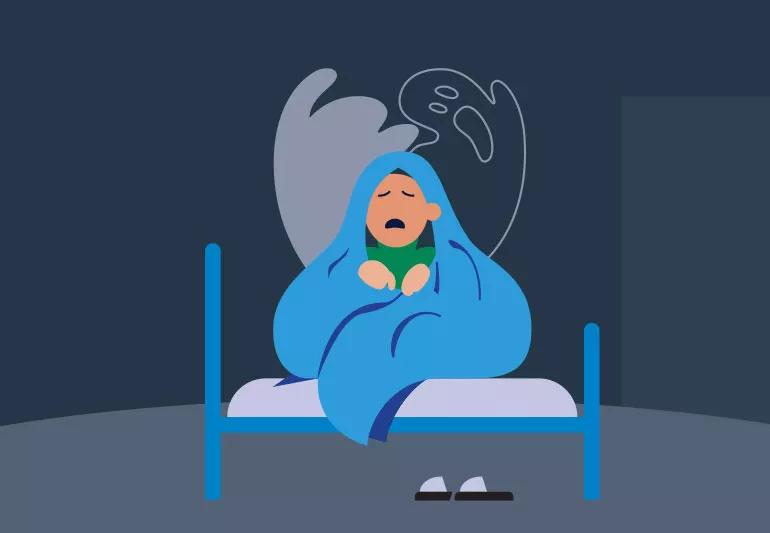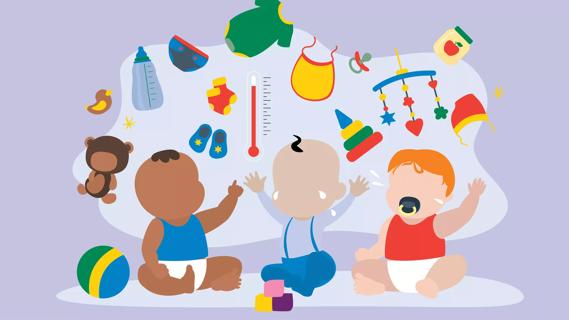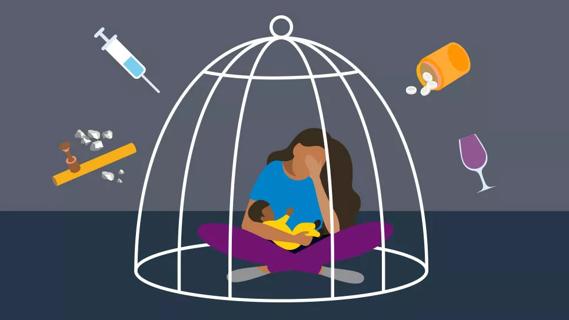Nightmares in children are common and more likely when your child is overtired or stressed

You probably know well that feeling of waking up in a cold sweat. You know you’re not really in danger, but you also know the nightmare you’re waking from was a real doozy.
Cleveland Clinic is a non-profit academic medical center. Advertising on our site helps support our mission. We do not endorse non-Cleveland Clinic products or services. Policy
But when kids have nightmares, the feeling that they’re still in trouble can seem all too real. They yell. They kick and squirm. And that mid-sleep intrusion can keep them (and you) from getting back to sleep anytime soon. Further complicating things, fear of future nightmares can make your child nervous about going to sleep the next night … and the next night … and so on.
“Nightmares in children can cause a cycle of sleeplessness,” says pediatric psychologist Catrina Litzenburg, PhD. “Nightmares can lead to a fear of the dark or a fear of sleeping. That fear can mean they get less sleep. But being overtired can lead to nightmares. It’s a vicious circle.”
It’s normal for kids to have nightmares. Up to half of all children have them. But why? And how can you help your child overcome them?
We ask Dr. Litzenburg to share some advice for helping your child when their nightmares become … well, nightmarish.
According to the Pediatric Sleep Council, researchers don’t think that babies have nightmares. It’s common for infants and toddlers to cry out when they wake during the night, but that doesn’t necessarily mean they’re having a nightmare.
But it’s a tough area to study. Babies and younger toddlers can’t readily express their fears and dreams, so we can’t know for sure what they’re experiencing in their sleep.
“It’s thought that very young kids, younger than 4 or so, generally don’t have fears at nighttime because they don’t developmentally know that there might be things to be afraid of,” Dr. Litzenburg explains. “We start to see more fear and nightmares in preschoolers. At that age, they’re becoming more creative thinkers, and they have the verbal skills to tell us what they are feeling and dreaming about.”
Younger kids, particularly those under the age of 7 or so, may experience sleep terrors more readily than nightmares. Here’s how you can tell the difference.
Nightmares happen during REM sleep. It’s a lighter phase of sleep. When your child has a nightmare, they wake up startled, confused and scared. They may cry out and be able to tell you about their nightmare.
Night terrors (or sleep terrors) typically occur during the deepest stage of non-REM sleep (also called “slow-wave sleep”). When your child has a sleep terror, they may yell or scream but they’re not actually awake. They won’t readily respond to your comforting words or hugs, and they won’t remember the episode in the morning.
“Younger children have more slow-wave sleep compared with adolescents and adults,” Dr. Litzenburg says. “There’s so much happening as their body is growing, they need to spend more time in that deep sleep pattern to encourage their healthy development and growth.”
We tend to think of sleep as a time when not much is happening. But looks can be deceiving.
When your kid nods off, their brain is working hard to process the day’s events and their emotions. Sleep also plays a role in learning and memory consolidation. According to the National Institutes of Health, recent research suggests sleep also plays a “housekeeping role.” That is, while you sleep, your brain clears away toxins that build up during the day.
And while your child’s brain is busy working its night shift, they dream a little dream. But on some nights, those dreams can turn dark, and the result is the stuff of nightmares.
Nightmares can be more common if your child is experiencing:
Nightmares in kids are common. But the content of those dreams is likely to vary as your children age.
“Preschoolers can have big imaginations, and they often can’t tell what’s real from what’s not, so often their nightmares are going to be things like being chased by imaginary creatures and that kind of thing,” Dr. Litzenburg explains. “As they grow up, your child’s nightmares are probably going to be more closely related to the stressors in their lives. Things like negative experiences at school or troubles with friends.”
An occasional nightmare can just be a blip on your child’s nocturnal radar. But recurring nightmares or nightmares that lead to sleep anxiety can wreak havoc on your children’s sleep needs — and yours, too.
Dr. Litzenburg suggests these four ways to help your child overcome their nightmares:
Toddlers and younger children especially can have a hard time understanding what’s real and what’s not. Case in point: Just try explaining to a preschooler why Elsa can make a snowman out of thin air and they can’t. (Go on. We dare you.)
It’s the same thing with nightmares. They can feel so alarmingly real that little ones can have a hard time separating what they experienced in their sleep from what’s actually happening.
“Nightmares can feel so vivid and real, they can be really scary,” Dr. Litzenburg says. “It can help to remind your child during the day that dreams aren’t real. You can say things like, ‘Nightmares can be really scary, but it’s not actually happening. You’re safe in your bed and in your room.’”
Another helpful tactic can be exploring your kid’s room with them and asking what they see. You can show them the tricks that their eyes can play on them, like, “See, it’s not a witch, it’s just your coat hanging from a chair.” Or, “See the shadows that are moving on your wall? Those aren’t bad guys creeping into the house, they’re the headlights from the cars driving by.”
Older children can take a more active role in separating fact from fiction. For children who can write, Dr. Litzenburg suggests they make notecards that they leave out in places they’ll see. On the cards, they can write down reminders like, “Nightmares aren’t real,” or “I am safe in my bed.”
Your child is more likely to have nightmares when they’re going on too little sleep.
“Nightmares are a form of parasomnia (sleep disruption), so they can be associated with poor sleep quality, or not getting enough sleep,” Dr. Litzenburg states.
Keep your kids to a regular bedtime schedule, based on the recommendations for how much sleep children need. (Check out these kids’ sleep tips for bedtime routines, strategies to keep kids in bed and more.)
When your child wakes up from a nightmare, or is delaying bedtime (again!) with protests that they’re scared to go to sleep, it can be easy to give in and bring them in your bed with you. While bed-sharing is a preference for some families, if it’s your intention for your child to sleep independently, you’ll want to stand firm on that.
“Even if you need to stay in your child’s room for a bit to help them relax and sleep, that’s OK,” Dr. Litzenburg advises. “When you take the child out of their room and let them sleep with you, though, it can reinforce the idea in their mind that their room somehow isn’t safe, which may not be the message you’re trying to send.”
If your kid is intent that they neeeeeeeeed youuuuuuuu to stay with them, Dr. Litzenburg suggests offering an intermediary.
“Having a comfort item that is special to them in their bed can help them develop a sleep onset association — your child can associate the thing with sleep,” she says. “It also helps them to be more independent because they can get comfort from their special item without needing a person.”
Sleep association items can be anything that your child can keep in bed that provides them comfort. Common ones are blankets and stuffed animals. Dr. Litzenburg says it can also be something like a parent’s shirt or pillowcase. Something that smells like a person they love can be a source of comfort for a child.
If nightmares are affecting your child’s school success or their ability to interact with friends or family, Dr. Litzenburg says it’s probably time to talk with their pediatrician or another healthcare provider about strategies to support them.
And remember, as a parent or primary caregiver, you know your child and their needs better than just about anyone. If you’re worried about your child’s nightmares and the effects that nightmares are having on their sleep and healthy development, don’t hesitate to contact a healthcare provider for support.
Learn more about our editorial process.

In babies under 12 months, honey may cause a serious illness called infant botulism

You can help strengthen your child’s immune system by focusing on hand washing and staying up-to-date on their vaccines

Lanugo — the soft, fine hair that develops in utero — is harmless and will shed within a few weeks

Crossed eyes in a newborn are fairly common, typically harmless and usually go away

A dental emergency, quick action is key to preventing long-term damage

Help and encourage them to brush and floss regularly, limit sugary foods and get routine dental checkups

Neonatal opioid withdrawal syndrome, or NOWS, can develop when a birthing parent uses opioids, nonmedical drugs or even some prescription drugs during pregnancy

Kids’ yoga can help kiddos become more aware of their physical, mental and emotional selves

Your metabolism may torch 1,300 to 2,000 calories daily with no activity

A gentle touch in all the right places may help drain your sinuses